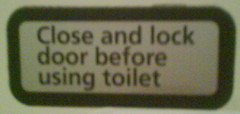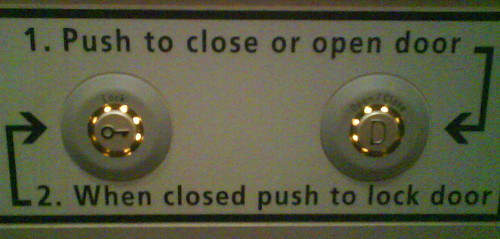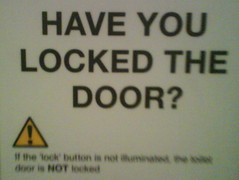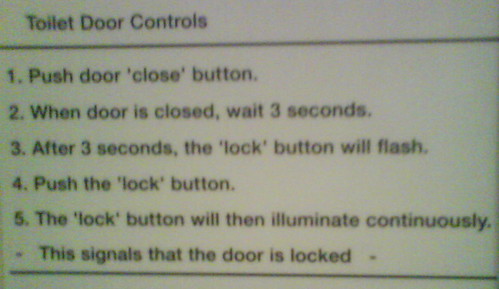What I found was a flabbergasting cascade of fail.
This advice is welcome:

Judging by the design and finish, this is the original signage.
But how to close and lock the door?

Ok, slightly non-obvious. Also, lacking some rather crucial information, it will turn out.
Seems as if more people than the lady I saw have had problems with the door, since there was this later, auxiliary sign:

Apologies for the poor quality. The text at the bottom reads "If the 'lock' button is not illuminated, the toilet doot is NOT locked" It might very well be closed, you see, but not locked. The original signage has braille attached, not so this vital little nugget of information (as I recall).
It seems that not even this prompt has quite been doing the job, as this third sign had also been added:

The visually impared (and those on urgent business) are now in serious trouble.
Being of an equiring mind, and finding the complexity of this control system too hard to believe, I did a few experiments and made an important discovery not covered by any of the above instructions but of no little importance I think.
If you press, or, let us say, accidentally nudge, the 'lock' button while the door is closed and locked the door (which is powered in the interest of the mobility impared, a good thing in itself) both unlocks and opens.
Now, how hard could this be? What am I missing from this design?
Still two buttons, their respective behaviour being:
- If the door is open, close and lock it. If the door is closed and locked, no action.
- If the door is closed and locked, open it. If the door is open, no action.
I'll be popping over to Switzerland in a couple of weeks, a place where they still take trains (and much else) seriously. And shall on the trip from Flughafen Zurich to the Haputbahnhof be paying close attention to the toilet doors.